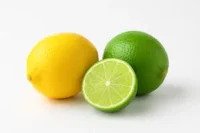How a Soil Tester Can Help Your Vegetable Garden Thrive
Published: 8 Feb 2025
Do you want your vegetable garden to grow healthy and strong? Good soil is necessary for a great garden. Plants need the right amount of nutrients, moisture, and the correct pH to grow well. But how can you tell if your soil is healthy?
A Soil tester is a handy tool that checks soil pH, moisture, and nutrients. From this, you can know what your soil needs and avoid guessing. With a soil tester, you will give your plants the best chance to grow big and healthy.
In this blog, we will talk about how a soil tester works, its usefulness, and how to use it to improve your vegetable garden.
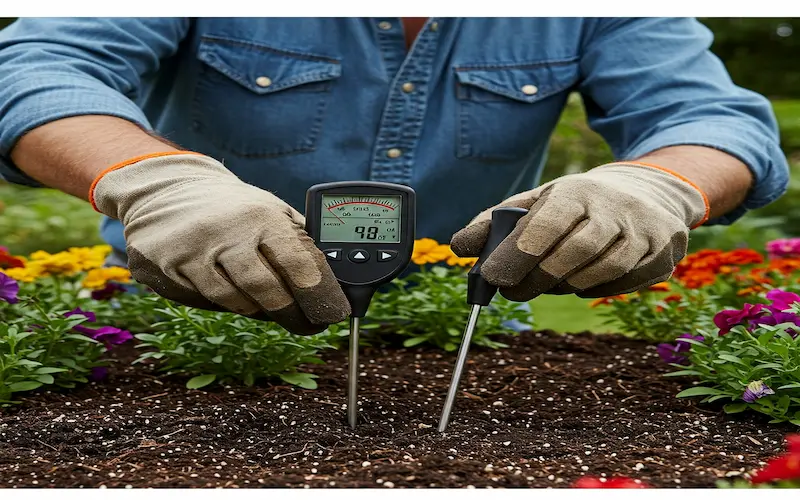
What is a Soil Tester?
A soil tester is a tool for checking the condition of your soil. It tells you about the soil’s pH level, moisture content, and available nutrients essential for growing healthy vegetables.
Plants struggle to absorb nutrients if your soil’s pH is too high or too low.
With a soil tester, you can quickly determine your soil needs and adjust to improve them. It works as a doctor for your soil. It gives you a diagnosis, and you can take the right steps to help your plants bloom.
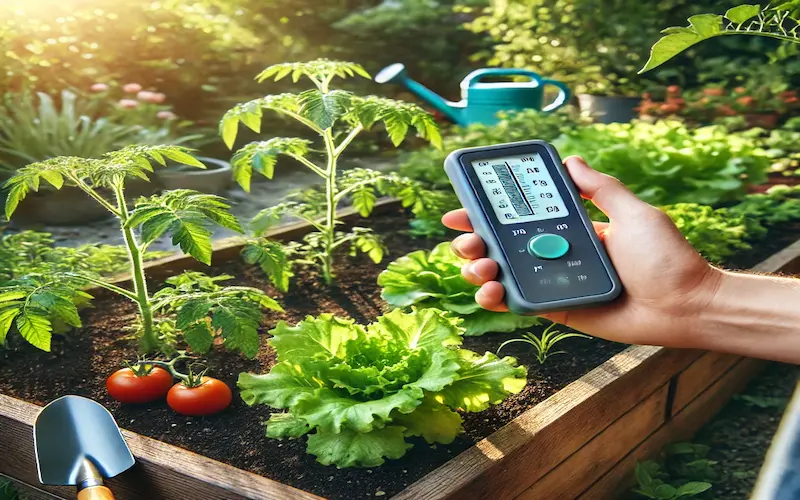
Types of Soil Testers
There are several soil testers, each with its features and uses. Here’s a look at the main types:
Analog (Manual) Soil Testers
- These are simple and affordable tools.
- They don’t need batteries or power to work.
- They measure basic parameters like pH and moisture by inserting probes into the soil.
- Best for: Home gardeners who want a quick and inexpensive check of their soil’s condition.
- Limitations: Less accurate than digital testers and hard for beginners to read.
Digital Soil Testers
- These testers have a digital display, making it easy to read the results.
- They measure pH, moisture, and sometimes temperature or light levels.
- Some advanced models even store data for multiple tests.
- Best for: Gardeners who want more precise and reliable results.
- Limitations: Slightly more expensive and require batteries or charging.
Professional Lab Testing Kits
- These are the most accurate but require sending soil samples to a laboratory.
- The lab provides a detailed report on pH, nutrient levels (nitrogen, phosphorus, potassium), and other soil properties.
- Best for: Farmers or serious gardeners who want a complete picture of their soil’s health.
- Limitations: It takes more time and costs more than at-home testers.
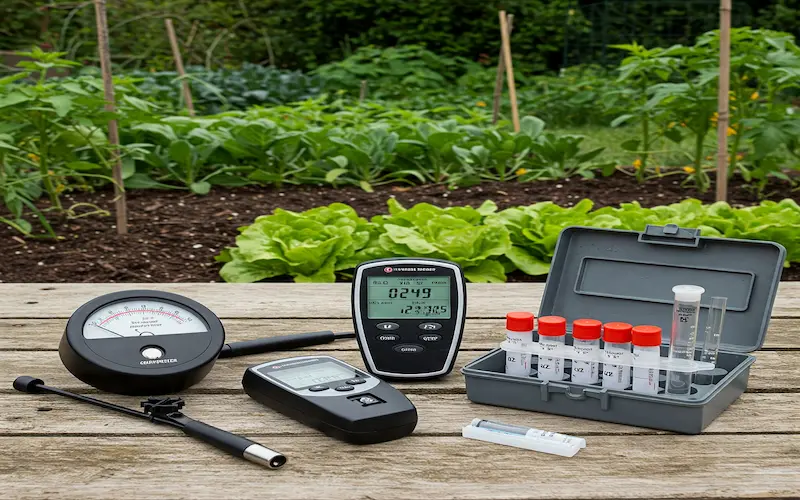
How Does a Soil Tester Work?
Soil testers measure key parameters like pH, moisture, and nutrients to help you understand your soil’s health. Let’s break down how they do it:
Measuring Soil pH
- The pH level shows the acidic or alkaline level of your soil.
- Vegetables grow best in a pH of 6.0 to 7.5 range.
- How it works: We insert the probe into the soil, and the tester detects the hydrogen ions in the soil to give a pH reading.
Checking Soil Moisture
- Moisture is a very important factor for plant growth. Too much or too little water can harm your vegetables.
- How it works: The tester measures the electrical conductivity in the soil, which changes based on moisture levels.
Nutrient Testing
- Some soil testers measure nutrients like nitrogen (N), phosphorus (P), and potassium (K), which are essential for plant growth.
- How it works: Chemical reactions or electronic sensors detect nutrient concentrations, giving you an idea of what’s missing in the soil.
Advanced Features in Digital Models
- Temperature and light sensors help monitor additional factors affecting plant growth.
A soil tester makes monitoring your garden’s health easy and helps you make better decisions. Whether you’re a beginner or an experienced gardener, it’s a valuable tool that saves time, effort, and money.
Why is Soil Testing Important for Vegetable Gardens?
If you want to grow healthy vegetables in your garden, understanding your soil is crucial. Soil testing helps you know what your soil needs and how to improve it. You can ensure your vegetables grow strong and healthy by checking for pH balance, nutrients, and moisture. Let’s explore how soil testing can benefit your garden.
Optimizes Plant Health
Soil testing helps you give your plants exactly what they need to thrive. Here’s how:
- Ensures Vegetables Get the Right Nutrients
- Vegetables need essential nutrients like nitrogen (N), phosphorus (P), and potassium (K) to grow well. A soil test tells you if your soil has enough of these nutrients. If something is missing, you can add the right fertilizer.
Example: If your soil is low in nitrogen, your plants may have yellow leaves and slow growth. A soil test helps you catch this early and fix it with a nitrogen-rich fertilizer.
- Helps Avoid Over-Fertilization
- Adding too much fertilizer can harm your plants. It can cause root burn and even pollute the environment. Soil testing shows how much fertilizer is needed, preventing waste and damage.
Example: Instead of guessing how much fertilizer to use, a soil test ensures you only add what’s necessary, keeping your plants and the environment healthy.
Prevents Common Soil Problems
Soil testing helps you catch and fix common problems that can harm your garden.
- pH Imbalance
- The pH level of your soil affects how well plants absorb nutrients. Your vegetables may not grow properly if the pH is too high (alkaline) or too low (acidic).
- Solution: A soil tester helps you adjust the pH by adding lime (to raise pH) or sulfur (to lower pH).
- Poor Drainage or Excess Moisture
- Too much water can lead to root rot, while too little can stress plants. Soil testing can help you measure moisture levels and improve drainage if needed.
- Example: If the soil is too wet, add compost or sand to improve drainage.
- Nutrient Deficiencies
- A lack of key nutrients can weaken your plants, making them more vulnerable to diseases and pests. A soil test reveals what’s missing so you can restore balance.
Improves Vegetable Yield
Healthy soil means healthy plants, and healthy plants give you a better harvest.
- Healthier Plants Produce Better Vegetables
- When your plants get the right nutrients, water, and pH balance, they grow faster and stronger, resulting in bigger, healthier vegetables.
Example: Tomatoes grown in nutrient-rich, well-balanced soil will be larger, juicier, and tastier than those grown in poor soil.
- Saves Time and Effort by Identifying Issues Early
- Soil testing helps you avoid problems before they get out of hand. Instead of guessing and wasting time trying different solutions, you can immediately target the issue.
Example: If your soil test shows a low potassium level, you can fix it immediately and avoid stunted growth or poor-quality vegetables.
In Summary
Soil testing is a smart step for any vegetable gardener. It helps create the perfect growing conditions, prevents common problems, and boosts vegetable yield. Whether growing tomatoes, carrots, or leafy greens, knowing what your soil needs is the key to a successful and productive garden.
Key Benefits of Using a Digital Soil Tester
A digital soil tester is a handy tool for every vegetable gardener. It gives you quick and accurate information about your soil’s condition, helping you make smart decisions for your garden. Unlike traditional soil testing methods, digital testers are easy to use and offer reliable results instantly. Let’s look at some key benefits.
Easy to Use and Convenient
One of the most significant advantages of a digital soil tester is its easy use.
- No Technical Skills Required
- You don’t need to be an expert to operate a digital soil tester. Most models are simple and come with clear instructions. Insert the probe into the soil and read the results on the display screen.
Example: A gardener who has never tested soil before can use a digital soil tester without training. It’s just as easy as checking the temperature with a thermometer!
- Provides Instant Readings
- Unlike lab testing, which can take days, a digital soil tester gives you immediate results. This is especially helpful when you need to make quick decisions about your vegetable garden.
Example: If your plants look unhealthy, you can immediately check the moisture level or pH with a digital tester and adjust watering or fertilizer.
Accurate and Reliable Results
Accuracy is essential for successful gardening; digital soil testers help you get reliable results.
- Helps Gardeners Make Informed Decisions
- Knowing the exact condition of your soil allows you to plan better. Whether you adjust the pH or add nutrients, you can make decisions based on real data instead of guessing.
Example: If your soil is too acidic, a digital tester will immediately show the pH level. You can then add lime to bring the pH level to the optimal range for your vegetables.
- Reduces Guesswork
- Many gardeners make the mistake of relying on guesswork regarding soil health. A digital soil tester eliminates the guesswork, ensuring your plants get exactly what they need.
Example: Instead of overwatering because your plants look dry, you can check the soil moisture with a digital tester to confirm if they need more water.
Cost-Effective Solution
Using a digital soil tester can save you money in the long run.
- Saves Money by Reducing the Need for Unnecessary Fertilizers
- When you know exactly what your soil needs, you can avoid wasting money on fertilizers that aren’t necessary. Over-fertilizing not only costs more but can also damage your plants.
Example: A soil test might reveal that your soil has enough phosphorus but lacks nitrogen. Instead of buying a general fertilizer, you can choose a nitrogen-rich one, saving money and effort.
- Prevents Crop Loss Due to Poor Soil Conditions
- Poor soil conditions can lead to weak plants and lower yields. With a digital soil tester, you can spot problems early and fix them before they affect your crops.
Example: If your soil has low potassium, your vegetables may not grow properly. Catching this early with a digital tester can prevent crop failure.
In Summary
A digital soil tester is a valuable tool for vegetable gardeners. It’s easy to use, provides fast and accurate results, and helps you save money by avoiding unnecessary expenses. With a digital tester, you can take better care of your soil and grow healthier, more productive vegetable plants.
How to Use a Digital Soil Tester
Using a digital soil tester is simple and requires no special skills. It’s a quick way to check the health of your soil and take action if needed. Follow these steps for accurate results.
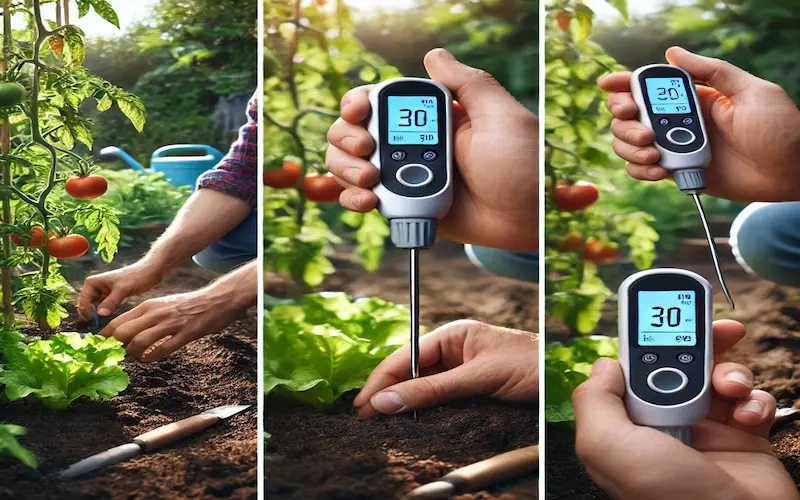
Step 1: Insert the Probe into the Soil
- Start by selecting the area of your garden where you want to test the soil.
- Remove any stones, leaves, or debris from the surface for a clean reading.
- Gently insert the probe into the soil. Make sure it goes deep enough to reach the root zone of your plants (usually 4–6 inches).
Tip: If the soil is too dry, add a little water to moisten it before inserting the probe. This will give you a more accurate reading.
Step 2: Wait for the Reading
- Once the probe is in the soil, wait for the device to show the results. Depending on the type of tester, this usually takes a few seconds to a minute.
- Most digital soil testers display pH, moisture, or nutrient level measurements on a screen.
Example: A moisture tester will indicate if the soil is dry, moist, or too wet. A pH tester will give you a numerical reading, usually between 3.5 and 9.0.
Step 3: Interpret the Results
Understanding the readings is essential for making the right decisions.
- Moisture Reading: Check if the soil is too dry, too wet, or at the ideal moisture level for your vegetables. Most vegetables prefer moderately moist soil.
- pH Reading: A pH between 6.0 and 7.5 is ideal for most vegetables. A reading outside this range may require adjustments.
- Nutrient Reading: If your tester measures nutrients like nitrogen, phosphorus, or potassium, it will help you decide whether your soil needs additional fertilizer.
Step 4: Take Corrective Actions if Needed
Based on the results, take action to improve your soil conditions.
- Water your plants thoroughly for Moisture Issues if the soil is too dry. If it’s too wet, improve drainage by adding compost or sand.
- For pH Imbalance: If the pH is too low (acidic), add lime to raise it. If it’s too high (alkaline), use sulfur to lower it.
- For Nutrient Deficiencies: Add specific fertilizers to address nutrient shortages. For example, apply a nitrogen-rich fertilizer if your soil is low in nitrogen.
Pro Tip: Test Soil at Different Spots
Test in several spots instead of just one to get a more accurate picture of your garden’s soil. Soil conditions can vary across your garden, especially if you have different types of plants or areas with more or less sunlight.
- Take 3–5 readings from different parts of the garden.
- Average the results for a clearer understanding of your overall soil health.
In Summary
Using a digital soil tester is an easy way to keep your vegetable garden healthy. It helps you check moisture, pH, and nutrients quickly. By following these steps, you can understand your soil’s needs and take the proper steps to improve it. Happy gardening!
Choosing the Right Soil Tester
Selecting the right soil tester to maintain a healthy vegetable garden is essential. With so many options available, knowing what to look for is important. A good soil tester should give you accurate information about your soil’s condition, be easy to use, and last a long time. Let’s consider the key factors when choosing a soil tester.
Factors to Consider
Measurement Features
The most important feature of a soil tester is what it can measure. Different testers offer different functions, so choose one that fits your gardening needs.
- pH Levels: Most vegetables bloom in soil between 6.0 and 7.5. A pH tester will help ensure your soil is within the proper range.
- Moisture Levels: Knowing how much moisture your soil holds is essential for preventing overwatering or underwatering your plants.
- Nutrient Levels: Some advanced digital testers can measure nutrients like nitrogen (N), phosphorus (P), and potassium (K). These are vital for healthy plant growth.
Example: A basic moisture meter will work if moisture is your primary concern. Opt for a tester covering pH and nutrients for a more complete soil analysis.
Durability and Ease of Use
Gardening tools should be sturdy and straightforward to operate.
- Durability: Look for testers with high-quality materials that can withstand regular use in outdoor conditions. Metal probes and weather-resistant cases are good indicators of durability.
- Ease of Use: Choose a soil tester with a straightforward design. Digital testers with clear buttons and instructions are great for beginners, and analog testers with color-coded dials are also easy to read.
Example: If you’re new to soil testing, avoid complicated models with too many features. Start with a basic tester that has simple functions.
Display and Accuracy
Accuracy is key when testing soil. A clear, easy-to-read display helps you get the most out of your soil tester.
- Digital Displays: These offer precise readings and are easier to read than analog models. Many digital testers have backlit screens, making them visible even in low light.
- Accuracy: Check customer reviews and product descriptions to ensure your tester provides reliable results. Some testers also include automatic calibration for better accuracy.
Example: Digital testers with LCDs are best for instant and precise readings. Analog testers are still helpful, but they may require a bit more interpretation.
Recommended Soil Testers
Here are some reliable brands and models to consider:
- Luster Leaf 1601 Rapitest Soil Tester
- Measures pH, nitrogen, phosphorus, and potassium
- Easy to use with color-coded test capsules
- Sonkir Soil pH Meter
- 3-in-1 functionality (pH, moisture, and light)
- No battery required
- Affordable and durable
- Kensington Digital Soil Tester
- Provides fast and accurate digital readings
- Measures pH and moisture levels
- User-friendly with a large LCD screen
- Atree Soil Tester
- Great for moisture and pH testing
- Lightweight and portable
- Perfect for beginner gardeners
In Summary
Choosing the right soil tester can significantly affect how well your vegetable garden grows. Focus on the most important features— pH, moisture, and nutrient testing. Make sure your tester is easy to use, durable, and accurate. Reliable brands like Sonkir, Luster Leaf, and Kensington offer great options for gardeners at all levels. With the right tool, you’ll keep your garden healthy and productive.
Comparison Chart for Different Soil Testers
Here’s a comparison chart for different soil testers that could help you choose the right one for your vegetable garden:
| Feature | Luster Leaf 1601 Rapitest | Sonkir Soil pH Meter | Kensington Digital Soil Tester | Atree Soil Tester |
| Type of Tester | Analog (Manual) | Digital | Digital | Analog (Manual) |
| Measurement Features | pH, Nitrogen, Phosphorus, Potassium | pH, Moisture, Light | pH, Moisture | pH, Moisture |
| Ease of Use | Easy to use with color-coded test capsules | Simple with no battery required | Fast and easy with LCD display | Lightweight and portable |
| Display | Color-coded dials | Digital LCD | Digital LCD | Analog scale |
| Durability | Durable, weather-resistant | Sturdy and reliable | Durable, weather-resistant | Lightweight but durable |
| Professional gardeners need fast results | Accurate for basic testing | Accurate for pH and moisture | Provides precise readings | Suitable for basic tests |
| Cost | Affordable | Budget-friendly | Mid-range | Affordable |
| Ideal For | Beginners and general gardeners | Small gardens, no need for batteries | Professional gardeners needing fast results | Beginners and small gardens |
| Additional Features | Includes test capsules for easy nutrient testing | No batteries needed; 3-in-1 functionality | Provides accurate digital readings in seconds | Compact and easy to store |
Summary of the Soil Testers:
- Luster Leaf 1601 Rapitest is great for those who want a simple, low-cost solution for testing basic soil nutrients like pH, nitrogen, phosphorus, and potassium. The color-coded dials make it easy for beginners.
- Sonkir Soil pH Meter: This digital, easy-to-use tester covers pH, moisture, and light levels. It is ideal for gardeners with smaller spaces or those who want a battery-free option.
- Kensington Digital Soil Tester: This more advanced option provides fast, accurate digital readings for pH and moisture levels. It is suitable for gardeners who want reliable, precise results.
- Atree Soil Tester: Lightweight and portable, this analog tester is a solid choice for gardeners looking for an affordable, basic solution for checking soil pH and moisture.
Common Mistakes to Avoid When Using a Soil Tester
Soil testing is a great way to understand your garden’s health and make informed decisions. However, a few common mistakes can lead to inaccurate results or ineffective tester use. Let’s look at gardeners’ most common mistakes when using soil testers and how to avoid them.
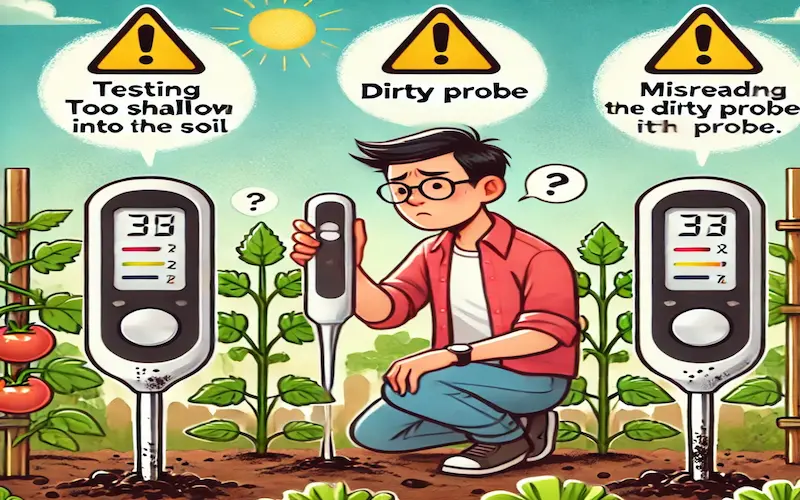
Testing Too Shallow or Too Deep
One of the most common mistakes when using a soil tester is inserting the probe too shallow or too deep into the soil. This can lead to incorrect readings, which may affect your gardening decisions.
Testing Too Shallow:
If you insert the probe only a few inches into the soil, you might not get an accurate representation of the soil conditions that affect plant roots. Shallow readings may only reflect surface moisture or pH levels, which can differ from those deeper down where the roots grow.
Testing Too Deep:
On the other hand, inserting the probe too deep might also give you misleading results. For example, if you test below the root zone (typically 4–6 inches deep for most vegetables), you might get readings that don’t reflect the actual conditions your plants are experiencing.
How to Avoid This Mistake:
- Always follow the manufacturer’s instructions regarding the depth at which the probe should be inserted.
- Generally, test the soil at a depth of 4–6 inches (for most vegetable gardens). This ensures you’re getting results relevant to your plant’s root zone.
Not Cleaning the Probe After Each Use
Another mistake gardeners make is failing to clean the probe after each use. Soil testers can accumulate soil and mineral deposits over time, affecting accuracy. If you don’t clean the probe after every test, the next reading might be impacted by leftover soil or debris, leading to misleading results.
Why Cleaning is Important:
- Soil residue can affect the readings, especially if left on the probe for a long time.
- The buildup of minerals and dirt can clog the probe, making it less effective in future tests.
- Keeping the probe clean helps ensure the accuracy of your readings over time.
How to Avoid This Mistake:
- After every use, gently wipe the probe with a clean cloth or sponge.
- If you’ve used the probe in moist or wet soil, dry it off before storing it.
- For a deeper clean, wash the probe with warm water (but avoid soap or chemicals). This will help maintain the device’s accuracy for longer.
Misinterpreting the Readings
Understanding soil test results is essential to making informed decisions about your garden. Misinterpreting the readings can lead to unnecessary actions or missed problems. For example, you may think your soil is too acidic when it’s just slightly off-balance, or you might mistake a high moisture level for a need to water your garden more.
Common Misinterpretations:
- pH Readings: A pH reading that’s too high or too low can lead to confusion if you don’t know the optimal range for your specific crops.
- Moisture Levels: Moisture meters can sometimes give readings that suggest your soil is too wet when it’s just right.
- Nutrient Deficiencies: Sometimes, the readings can indicate nutrient imbalances that might not be as critical as they appear, primarily if the tester doesn’t provide a complete soil analysis.
How to Avoid This Mistake:
- Always cross-check your test results with the ideal range for the specific plants you’re growing.
- Take multiple readings from different parts of your garden and average the results for a better overall picture.
- Consult local gardening guides or an expert to help interpret the results if in doubt.
- Use soil test results as part of the puzzle—consider other factors like weather conditions, plant types, and general garden care.
In Summary
To get the most out of your soil tester, avoid these common mistakes:
- Test at the correct depth—not too shallow or too deep.
- Clean the probe after every use to maintain accuracy.
- Interpret the results carefully—don’t jump to conclusions without considering all factors.
You can make better decisions and keep your vegetable garden thriving by avoiding these errors!
Ideal Soil Conditions for Common Vegetables
Here’s a simple cheat sheet with ideal soil conditions for common vegetables, which will help guide your gardening efforts:
| Vegetable | pH Range | Moisture Level | Ideal Soil Type | Nutrient Requirements |
| Tomatoes | 6.0 – 6.8 | Moderate (well-drained) | Loamy, Well-drained | High in potassium and phosphorus |
| Moist but well-drained | 6.0 – 7.0 | Moist but well-drained | Loamy, Slightly Acidic | Needs a balanced mix of nutrients |
| Carrots | 6.0 – 6.8 | Moderate (not too wet) | Sandy, Loamy | Low in nitrogen, moderate in potassium |
| Cucumbers | 6.0 – 7.0 | Moist but well-drained | Loamy, Slightly Acidic | High in potassium and phosphorus |
| Peppers | 6.0 – 6.8 | Moderate (well-drained) | Loamy, Well-drained | High in potassium and calcium |
| Spinach | 6.5 – 7.0 | Moist, well-drained | Loamy, Slightly Acidic | High in nitrogen |
| Beans | 6.0 – 6.5 | Moist, but well-drained | Loamy, Well-drained | Moderate in nitrogen |
| Potatoes | 5.5 – 6.5 | Moderate (not too wet) | Sandy, Loamy | High in potassium and phosphorus |
| Radishes | 6.0 – 7.0 | Moist, well-drained | Loamy, Slightly Acidic | Low in nitrogen, balanced phosphorus |
| Zucchini | 6.0 – 6.5 | Moist but well-drained | Loamy, Well-drained | High in potassium and phosphorus |
| Onions | 6.0 – 7.0 | Moderate (well-drained) | Loamy, Slightly Acidic | High in nitrogen |
| Broccoli | 6.0 – 7.0 | Moist, well-drained | Loamy, Slightly Acidic | High in nitrogen and potassium |
| Cauliflower | 6.0 – 7.0 | Moist, well-drained | Loamy, Slightly Acidic | High in nitrogen and potassium |
| Cabbage | 6.0 – 6.8 | Moist, but well-drained | Loamy, Slightly Acidic | Moist but well-drained |
Key Tips for Ideal Soil Conditions:
- pH: Most vegetables prefer a slightly acidic to neutral soil pH, generally between 6.0 and 7.0. Use a soil tester to monitor pH and adjust as needed.
- Moisture: Vegetables generally like moist but well-drained soil. Too much water can lead to root rot, while too little can stunt growth.
- Soil Type: Loamy soil is often considered ideal for vegetable gardening. It holds nutrients well and drains excess water effectively. Sandy soil is great for root vegetables like carrots and potatoes, while clayey soils should be amended with organic material for better drainage.
- Nutrient Needs: Different vegetables have varying nutrient needs. Nitrogen promotes leafy growth, while phosphorus encourages strong roots and flowers. Potassium helps with overall plant health.
This cheat sheet will help you choose the right soil conditions for your garden and improve your vegetable-growing success.
FAQs about Soil Testers
Soil testing is essential to understanding your garden’s needs and ensuring your plants thrive. However, you don’t need to test your soil constantly. Here’s how often you should consider testing it:
- Annual Testing: It is a good practice to test your soil at least once a year. This is especially important if you grow vegetables in the same soil yearly, as nutrient levels fluctuate each growing season.
- Before Planting: It’s a great idea to test the soil before planting new crops. This gives you a clear idea of the current soil condition and allows you to make necessary adjustments before planting.
- When You Notice Problems: If your plants are not growing well, showing signs of nutrient deficiency, or you notice yellowing leaves, testing the soil can help identify the underlying issue.
- After Fertilization: If you’ve recently added fertilizers or soil amendments, it’s a good idea to test your soil again to check the effectiveness and ensure you haven’t over-fertilized.
Overall, annual testing is usually enough for most home gardeners. However, specific crops or unique soil conditions may require more frequent testing.
Yes, you can use a soil tester for all types of vegetables! Soil testers are designed to measure the most critical soil factors—such as pH, moisture, and nutrient levels—regardless of the type of vegetable you’re growing. However, different vegetables have varying ideal soil conditions, so it’s essential to understand how your soil’s current readings may affect different crops:
- pH Levels: Vegetables like tomatoes, peppers, and beans thrive in slightly acidic to neutral soil (pH of 6.0 – 7.0), while root crops like carrots and radishes prefer slightly more acidic or neutral pH levels (around 6.0).
- Moisture: While most vegetables require moist, well-drained soil, some, like lettuce and spinach, need consistent moisture. Too much moisture can cause problems for root vegetables, such as potatoes and carrots, so monitoring this is key.
- Nutrients: Different vegetables have different nutrient needs. For example, leafy greens like spinach and lettuce need high nitrogen levels, while tomatoes and cucumbers benefit from higher phosphorus levels for strong roots and fruits.
In short, soil testers can work for all types of vegetables, but it’s essential to adjust them based on each crop’s specific needs.
Conclusion
In this article, we have covered the benefits of using a soil tester for Vegetable Gardens. I recommend trying a digital soil tester if you’re serious about improving your vegetable yield. It’s an affordable tool that can save you time and money in the long run. Why not take the first step toward a healthier garden? Grab a soil tester and start testing today!

- Be Respectful
- Stay Relevant
- Stay Positive
- True Feedback
- Encourage Discussion
- Avoid Spamming
- No Fake News
- Don't Copy-Paste
- No Personal Attacks



- Be Respectful
- Stay Relevant
- Stay Positive
- True Feedback
- Encourage Discussion
- Avoid Spamming
- No Fake News
- Don't Copy-Paste
- No Personal Attacks



